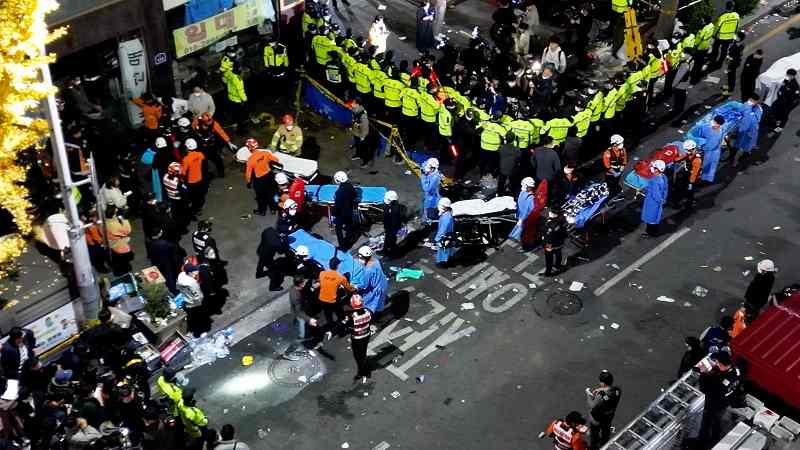
Rescue workers work at the scene where a stampede during Halloween festivities killed an injured many people at the popular Itaewon district in Seoul, South Korea, October 30, 2022.
12:58 JST, October 30, 2022
On Saturday – in what appears to be one of the deadliest disasters in South Korea since 2014 – nearly 150 people were killed in a crowd crush during Halloween celebrations in Itaewon, the first large-scale partying for the holiday since the pandemic began.
The event can be described as a crowd crush or surge, but not a stampede, said G. Keith Still, a crowd safety expert and visiting professor of crowd science at the University of Suffolk in England. A crush or surge happens when people are packed together in a confined space and there’s movement such as pushing that causes the crowd to fall over. Essentially, Still said, a “domino effect.”
A stampede implies that people had space to run, which was not the case in Itaewon, he added. The more people that are in the crowd, the greater the force of the crowd crush is.
“The whole crowd falls over as one, and if you’re in a confined space, people then can’t get up again,” Still said.
In a Twitter thread on Saturday, one person who said they were in the crowd described people “falling like dominoes and screaming.”
“I really felt like I would be crushed to death,” they said in another tweet. “And I breathed through a hole and cried and thought I am dying.” The person continued, writing that they were near the top of the crowd, crying, “Please save me!” and people nearby pulled them up.
During a surge, the pressure from above and below people in the crowd makes it hard to breathe because their lungs need space to expand. Still said it takes about six minutes to go into compressive or restrictive asphyxia, the probable cause of death for people killed in a crowd crush.
People can also injure their limbs and lose consciousness when they are struggling to breathe and escape the crowd. It takes about 30 seconds of compression to restrict blood flow to the brain and for people in a crowd crush to get lightheaded.
Crowd surges can be triggered by many tight situations, for example when people push others or if someone trips, Still said. But the events are not usually caused by people in distress or pushing to get out of a crowd. Those reactions typically come after the crowd starts collapsing, Still said.
“People don’t die because they panicked,” he said. “They panic because they’re dying. So what happens is, as bodies fall over, as people fall on top of each other, people struggle to get up and you end up with arms and legs getting twisted together.”
Similar events have happened around the world, including this month at a soccer stadium in Indonesia that left 130 dead and last year at the Astroworld Festival in Texas that left 10 dead.
At Astroworld, most of the fans who died were near one another in the venue’s south quadrant. The venue had metal barriers surrounding it, which would have compressed people if a crowd had surged near it, allowing no way to regulate the flow of people.
Although the crush in Itaewon happened on a street, the crowd was so densely packed that movement was extremely restricted and there was no way for people to exit vertically, said Norman Badler, a professor at the University of Pennsylvania who has researched crowd compression.
Over the past year, crowds have been gathering more frequently since pandemic restrictions have been widely relaxed, another factor in recent crowd surges. More people are probably attending events such as the Halloween celebrations in Itaewon, Still said, because they’ve been restricted for so long.
He added that the increase in mass gatherings that are now allowed underscores the need for crowd management training, which had tapered off when the pandemic hit because large events were uncommon.
Martyn Amos, a professor at Northumbria University in England who studies crowds, said those large events need proper planning and people who are trained to manage crowds.
“The general point is that these incidents will keep happening so long as we don’t put in place proper crowd management processes that anticipate, detect and prevent dangerously high crowd densities,” Amos said in a statement to The Washington Post.
"News Services" POPULAR ARTICLE
-

American Playwright Jeremy O. Harris Arrested in Japan on Alleged Drug Smuggling
-

Japan’s Nikkei Stock Average as JGB Yields, Yen Rise on Rate-Hike Bets
-

Japan’s Nikkei Stock Average Licks Wounds after Selloff Sparked by BOJ Hike Bets (UPDATE 1)
-

Japan’s Nikkei Stock Average Buoyed by Stable Yen; SoftBank’s Slide Caps Gains (UPDATE 1)
-

Japanese Bond Yields Zoom, Stocks Slide as Rate Hike Looms
JN ACCESS RANKING
-

Keidanren Chairman Yoshinobu Tsutsui Visits Kashiwazaki-Kariwa Nuclear Power Plant; Inspects New Emergency Safety System
-

Imports of Rare Earths from China Facing Delays, May Be Caused by Deterioration of Japan-China Relations
-

Tokyo Economic Security Forum to Hold Inaugural Meeting Amid Tense Global Environment
-

University of Tokyo Professor Discusses Japanese Economic Security in Interview Ahead of Forum
-

Japan Pulls out of Vietnam Nuclear Project, Complicating Hanoi’s Power Plans






















